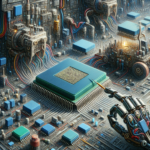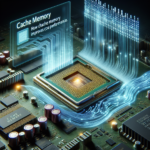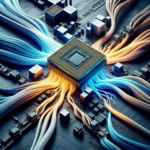The Role of CPUs in Robotics and Automation

The Role of CPUs in Robotics and Automation
In the rapidly evolving fields of robotics and automation, the Central Processing Unit (CPU) plays a pivotal role. As the brain of any computing system, the CPU is responsible for executing instructions and processing data, making it indispensable in the development and operation of robots and automated systems. This article delves into the multifaceted role of CPUs in robotics and automation, exploring their functions, types, and future trends.
Understanding CPUs: The Basics
What is a CPU?
The Central Processing Unit (CPU) is the primary component of a computer that performs most of the processing inside a computer. It executes instructions from programs through basic arithmetic, logic, control, and input/output (I/O) operations. In essence, the CPU is the brain of the computer, orchestrating the operations of all other components.
Key Components of a CPU
A CPU consists of several key components:
- Arithmetic Logic Unit (ALU): Performs arithmetic and logical operations.
- Control Unit (CU): Directs the operation of the processor.
- Registers: Small, fast storage locations for temporary data.
- Cache: A smaller, faster memory that stores copies of frequently accessed data from main memory.
CPUs in Robotics
Processing Power and Speed
In robotics, the CPU’s processing power and speed are crucial. Robots often need to perform complex calculations and process large amounts of data in real-time. For instance, a robot navigating through an environment must continuously process sensor data, make decisions, and execute movements. High-performance CPUs enable robots to perform these tasks efficiently and accurately.
Real-Time Processing
Real-time processing is essential in robotics. The CPU must process data and execute instructions within a strict time frame to ensure the robot’s actions are timely and precise. This is particularly important in applications like autonomous vehicles, where delays in processing can lead to accidents.
Multitasking and Parallel Processing
Modern CPUs support multitasking and parallel processing, allowing robots to perform multiple tasks simultaneously. For example, a humanoid robot might need to walk, recognize objects, and respond to voice commands all at the same time. Multicore CPUs, which contain multiple processing units, enable such parallelism, enhancing the robot’s overall performance.
CPUs in Automation
Control Systems
In automation, CPUs are integral to control systems. They manage the operation of machinery and processes, ensuring they run smoothly and efficiently. For example, in a manufacturing plant, the CPU might control the assembly line, coordinating the actions of various machines to produce a final product.
Data Processing and Analysis
Automation systems often rely on large amounts of data to make decisions. The CPU processes this data, analyzing it to optimize operations. For instance, in a smart factory, the CPU might analyze data from sensors to predict equipment failures and schedule maintenance, reducing downtime and improving productivity.
Integration with Other Technologies
CPUs in automation systems often work in conjunction with other technologies, such as sensors, actuators, and communication networks. The CPU processes data from sensors, sends commands to actuators, and communicates with other systems to ensure seamless operation. This integration is vital for the efficiency and effectiveness of automated systems.
Types of CPUs Used in Robotics and Automation
General-Purpose CPUs
General-purpose CPUs, like those found in personal computers, are often used in robotics and automation. They offer a good balance of performance and flexibility, making them suitable for a wide range of applications. Examples include Intel’s Core and AMD’s Ryzen processors.
Embedded CPUs
Embedded CPUs are designed for specific tasks and are often used in embedded systems, which are dedicated to particular functions within larger systems. These CPUs are typically more power-efficient and reliable, making them ideal for use in robots and automated machinery. Examples include ARM Cortex and Intel Atom processors.
Real-Time CPUs
Real-time CPUs are designed to handle real-time processing requirements, ensuring that tasks are completed within strict time constraints. These CPUs are crucial in applications where timing is critical, such as in autonomous vehicles and industrial automation. Examples include the Texas Instruments TMS320 series and the NXP i.MX series.
Future Trends in CPUs for Robotics and Automation
Artificial Intelligence and Machine Learning
The integration of artificial intelligence (AI) and machine learning (ML) into robotics and automation is driving the development of specialized CPUs. These CPUs, often referred to as AI accelerators or neural processing units (NPUs), are designed to handle the intensive computations required for AI and ML algorithms. This trend is expected to continue, with CPUs becoming increasingly optimized for AI and ML tasks.
Edge Computing
Edge computing involves processing data closer to the source, rather than relying on centralized cloud servers. This approach reduces latency and improves real-time processing capabilities. CPUs designed for edge computing are becoming more prevalent in robotics and automation, enabling faster and more efficient data processing at the edge of the network.
Quantum Computing
While still in its early stages, quantum computing holds promise for revolutionizing robotics and automation. Quantum CPUs, or quantum processing units (QPUs), can perform complex calculations much faster than traditional CPUs. As quantum computing technology advances, it could enable new levels of performance and capabilities in robotics and automation.
FAQ
What is the role of a CPU in a robot?
The CPU in a robot acts as its brain, processing data from sensors, making decisions, and controlling the robot’s actions. It performs complex calculations and executes instructions to ensure the robot operates efficiently and accurately.
Why is real-time processing important in robotics?
Real-time processing is crucial in robotics because it ensures that the robot’s actions are timely and precise. Delays in processing can lead to errors or accidents, especially in applications like autonomous vehicles or industrial robots.
What types of CPUs are used in automation systems?
Automation systems use various types of CPUs, including general-purpose CPUs, embedded CPUs, and real-time CPUs. The choice of CPU depends on the specific requirements of the application, such as processing power, power efficiency, and real-time capabilities.
How are AI and machine learning influencing CPU development?
AI and machine learning are driving the development of specialized CPUs, known as AI accelerators or neural processing units (NPUs). These CPUs are optimized for the intensive computations required for AI and ML algorithms, enabling more efficient and powerful AI applications in robotics and automation.
What is edge computing, and how does it relate to CPUs in robotics?
Edge computing involves processing data closer to the source, rather than relying on centralized cloud servers. CPUs designed for edge computing enable faster and more efficient data processing at the edge of the network, reducing latency and improving real-time processing capabilities in robotics and automation.
Conclusion
The role of CPUs in robotics and automation is both fundamental and transformative. As the central processing units of these systems, CPUs enable robots and automated machinery to perform complex tasks, process data in real-time, and operate efficiently. With advancements in AI, edge computing, and quantum computing, the capabilities of CPUs are continually expanding, paving the way for more sophisticated and powerful robotics and automation solutions. As these technologies evolve, the importance of CPUs will only grow, driving innovation and progress in these dynamic fields.




